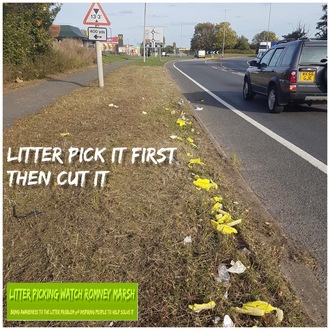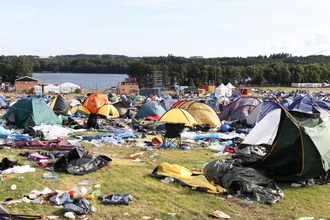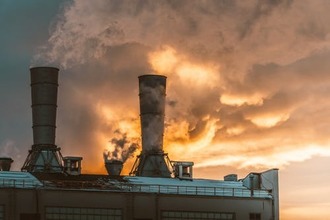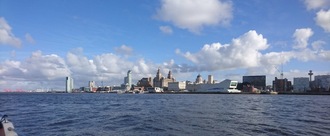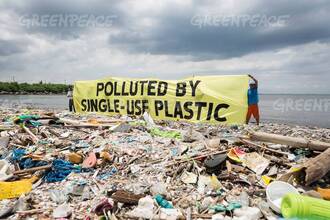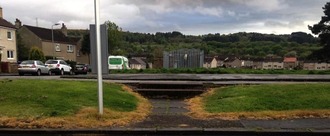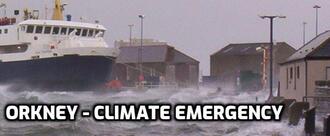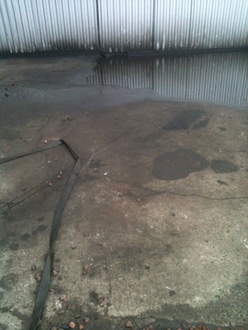-
Litter Pick Grass Verges First Before Cutting ThemMowing grass before litter picking creates a whole host of problems for the environment and us, One single piece of litter cut into minute pieces, often dangerous as in shards of aluminum, glass, plastic. Affecting wildlife habitat, infants play areas, parks, dog walking areas etc who all are vulnerable to injury by this senseless act. These pieces are often washed into storm drains where they are carried out to sea to return to our beaches as micro plastics etc, eaten by fish then by us, polluting everywhere as they go. Litter is a big enough problem without accelerating it. Visually it’s an eyesore to the street scene. Should the grass be cut as often with nature’s pollen collectors struggling to exist, they need all the help we can give them. So it makes sence to me cut grass less and before doing so clear the area of litter, it’s not rocket science371 of 400 SignaturesCreated by Eric Brown
-
Say NO to Stobart's and Six/56WBC's planning department together with Stobart's, Langtree and Panattoni (all multi-national property and logistics companies) are determined to forever destroy 346,000m sq of South Warrington's Green Belt land. That's equivalent to 54 Wembleys. It will mean easily 2000 additional vehicular movements PER HOUR 365/24/7 on our already overloaded roads, junctions and surrounding motorways. Air pollution in Warrington is one of the worst in the UK. It is THE worst for the most dangerous small particulates (PM2.5) in the whole of the UK (World Health Organisation Air Quality Database, 2018). This is a legacy that we MUST NOT PASS ON to our children and future generations. RSWF will use this petition to hand over when each application comes before the DMC. Please sign this petition to make your objection clear and share widely. Thank you.2,240 of 3,000 SignaturesCreated by Rethinking South Warrington's Future RSWF

-
Stop oil exploration in Cardigan Bay Marine SACCardigan bay Marine SAC is an important breeding and feeding area for bottle nose dolphins and harbour porpoises. An environmental impact assessment carried out by London based Orbis Energy has admitted that the proposed seismic activity would have detrimental consequences affecting all forms of wildlife including shellfish, marine mammals and seabirds as well as fish spawning grounds. Previous extensive seismic surveys have been conducted and have revealed no commercial quantities of hydrocarbons within the area and do not need to be repeated. If however there were any viable reserves discovered the extraction of such would cause irreparable damage to this sensitive marine area and the life it supports whilst making a mockery of the designation of a marine SAC. Equally at a time when Wales has declared a climate emergency to proceed with the extraction of more fossil fuels is sheer madness. If you have ever been fortunate enough to witness the bottlenose dolphins of Cardigan Bay you will understand the importance of protecting their precious habitat for future generations, if not I sincerely hope that you will be able to one day! Please sign and share this petition to ensure we can take it to the UK Government and overturn this reckless decision.7,500 of 8,000 SignaturesCreated by Steve Parkin
-
Stop Throwaway TentsAn estimated 250,000 tents are abandoned in the UK each summer, most of these at festivals. These tents are rarely reused and the materials they are made from are generally not recyclable, thus the great majority end up in landfill. At a time when we are facing an existential environmental crisis, when we are experiencing the earths sixth extinction event with around 5000 species disappearing each year. When the sea, air and earth is being increasingly poisoned through man made contaminants, and the population is growing to the extent that there are 225,000 extra people to support each day, we have to rapidly adapt to the situation and reduce our impact on the planet. If we want to save our civilisation and our beautiful planet then we have to stop using single use products. NOW!101 of 200 SignaturesCreated by Danny Ardeshir
-
Stop the throwaway culture of 'festival tents'More than 250,000 tents get left behind at UK festivals every year including Glastonbury and Reading and Leeds. The average tent is mostly made of plastic - which is equivalent to 8,750 straws or 250 pint cups. But some of the UK's biggest sports and leisure retailers are still advertising tents as 'festival tents,' which gives the impression that you only need to use them once. There is a myth that tents left behind when people leave the festival are collected and handed to charities. The reality is that the huge majority don't and will ultimately end up in landfill. With more and more festivals pledging to go plastic free and climate crisis on more and more people's minds, urgent action needs to be taken, with the help of the UK's biggest retailers.111,788 of 200,000 SignaturesCreated by Stephen Watts
-
Stop the St Philip's Marsh Gas PlantThe gas plant is 90 m from a school in an area which already has dangerous levels of air pollution. Bristol Council passed a climate emergency motion in November 2018 and has committed to becoming carbon neutral by 2030. By approving a power generation plant that burns fossil fuels the council is complicit with corporations that are driving the climate crisis. UK Parliament declared climate emergency on May 1st 2019.1,326 of 2,000 SignaturesCreated by LILY LEE
-
Liverpool & Merseyside: Declare Climate EmergencyIn declaring a climate emergency, they would follow the lead of both Parliament and more than fifty councils around the country. This declaration should include a pledge to make the city zero carbon by 2030, a commitment to green municipal energy generation and distribution, and ensure that there is properly democratic citizen representation in the development of all aspects of the city's climate justice programme. Bold climate action needs to be taken for the well-being of current and future generations, both locally and worldwide, and to ensure that the fragile balance in valuable ecosystems is maintained. Implementing this strategy could generate thousands of climate jobs in Merseyside. This call for action is made in the light of the UN’s Intergovernmental Panel on Climate Change report, published in October 2018, that concluded that humanity has 11 years for “ambitious action from national and sub-national authorities, civil society, the private sector, indigenous peoples and local communities” to deliver the “rapid and far reaching transitions in land, energy, industry, buildings, transport, and cities” needed to avoid tipping point. We are a group of Liverpool climate activists who want to work with all those on Merseyside that wish to see Climate Emergency declared and urgent implementation of these actions.1,885 of 2,000 SignaturesCreated by Clara Paillard
-
Tell Amazon.co.uk to stop using single use plastic packagingAmazon's recent use of plastic envelopes seems to an extraordinary decision to make in the wake of concerns about plastic in the oceans and in the landscape. Amazon seem utterly unconcerned by this and appear to have chosen to take the attitude that they are bigger than the environment and have stopped bothering to listen to customers who complain.168 of 200 SignaturesCreated by Stephen Thompson
-
Glyphosate (Round-up) Ban by uk CouncilsThousands and thousands of gallons of this potentially dangerous herbicide is ruining our towns the length and breadth of Britain. In a time of loosing something like 40 million birds and flying insects dropping some 70odd%. We are killing every wild flower on every grass verge, park path, walkway, council garden and road verge. This spraying is both destructive to our wildlife, costly at some £10.000 a year in renfrewshire alone as well as being a total eyesore. What environmental official endorses a product at such expense, potentially linked to cancer as well as leaving such a hideous sight, in the form of burnt brown grass? Our bees are already in such peril from lack of food. Dandelion is a vital source of food. What we desperately need is a campaign to change perceptions. A flower is a flower not a weed. We need as many as we can get if we are to save ourselves as well as our wild creatures.25,314 of 30,000 SignaturesCreated by Stephen McBride
-
Crail Raceway Speed and NoiseThe is important to the locals, the villagers, holidaymakers as well as the wildlife coming for the woodlands, the beach and a quiet place to live. Foolowing the letter about speed in last week's Crail Matters, I am giving people another chance to voice their feelings about this matter. In addition, many people have found the manager of the site unnessarily rude and confrontational for no apparent reason Simply go to this website and have your say: https://bit.ly/2PzUvYd If you are not online, give your name and postcode to me [email protected] Tracy Fryer17 of 100 SignaturesCreated by Margaret Fryer
-
Declare a Climate Emergency - OrkneyHumans have already caused irreversible climate change and ecological devastation. The impacts of which are being felt around the world. Global temperatures have already increased by 1.1 degree Celsius from pre-industrial levels. Atmospheric CO2 levels are above 400 parts per million (ppm). This far exceeds the 350ppm deemed to be a safe level for humanity and all the other species that we co-exist with and depend on; In order to reduce the chance of runaway global warming and limit the effects of climate breakdown, and ecocide, it is imperative that we as a species reduce our CO2e (carbon dioxide equivalent) emissions from their current 6.5 tonnes per person per year to 1 tonne as soon as possible, and live within the resource means of our planet.; Councils around the world are responding by declaring a ‘Climate Emergency’ and committing resources to address this emergency and Orkney is in a unique position to contribute to cutting emissions through its leading role in developing renewable energy. The full text of a motion that we will ask the Council to pass will be published on the Extinction Rebellion Facebook page.317 of 400 SignaturesCreated by George Vickers
-
Dr LESLEY HERD GLASGOWS OWN ERIN BROCOVITCH NEEDS YOUR HELP.Dr Herds Veterinary Rehabilitation Clinic and Veterinary Accident and Emergency Clinic was a first in Scotland , It was closed due to contamination and burning of controlled waste fire from a contaminating car repair Garage. This could have resulted in the death of Dr Herd, indeed it closed her clinic . Both these Agencies should have acted sooner to protect Lesley and the surrounding environment , Please help me get this national disgrace investigated . These public bodies are using law to protect them from legal action .. It is in the public interest to hold them to account . See more here: https://www.glasgowlive.co.uk/news/glasgow-news/glasgow-vet-forced-practice-garage-15264540655 of 800 SignaturesCreated by Tom Purdy
Hello! We use cookies to improve your experience by providing insights into how the site is being used. Find out more.
